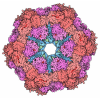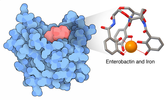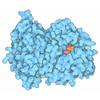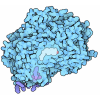+ Open data
Open data
- Basic information
Basic information
| Entry | Database: PDB / ID: 8b0f | |||||||||
|---|---|---|---|---|---|---|---|---|---|---|
| Title | CryoEM structure of C5b8-CD59 | |||||||||
 Components Components |
| |||||||||
 Keywords Keywords |  IMMUNE SYSTEM / Complement / IMMUNE SYSTEM / Complement /  inhibitor / inhibitor /  complex / pore-forming complex / pore-forming | |||||||||
| Function / homology |  Function and homology information Function and homology informationnegative regulation of activation of membrane attack complex / Terminal pathway of complement /  membrane attack complex / complement binding / membrane attack complex / complement binding /  regulation of complement-dependent cytotoxicity / regulation of complement-dependent cytotoxicity /  regulation of complement activation / Activation of C3 and C5 / negative regulation of macrophage chemotaxis / Cargo concentration in the ER / regulation of complement activation / Activation of C3 and C5 / negative regulation of macrophage chemotaxis / Cargo concentration in the ER /  complement activation, alternative pathway ...negative regulation of activation of membrane attack complex / Terminal pathway of complement / complement activation, alternative pathway ...negative regulation of activation of membrane attack complex / Terminal pathway of complement /  membrane attack complex / complement binding / membrane attack complex / complement binding /  regulation of complement-dependent cytotoxicity / regulation of complement-dependent cytotoxicity /  regulation of complement activation / Activation of C3 and C5 / negative regulation of macrophage chemotaxis / Cargo concentration in the ER / regulation of complement activation / Activation of C3 and C5 / negative regulation of macrophage chemotaxis / Cargo concentration in the ER /  complement activation, alternative pathway / complement activation, alternative pathway /  complement activation / complement activation /  chemokine activity / COPII-mediated vesicle transport / chemokine activity / COPII-mediated vesicle transport /  retinol binding / retinol binding /  endopeptidase inhibitor activity / tertiary granule membrane / positive regulation of vascular endothelial growth factor production / specific granule membrane / COPI-mediated anterograde transport / endopeptidase inhibitor activity / tertiary granule membrane / positive regulation of vascular endothelial growth factor production / specific granule membrane / COPI-mediated anterograde transport /  complement activation, classical pathway / positive regulation of chemokine production / complement activation, classical pathway / positive regulation of chemokine production /  transport vesicle / endoplasmic reticulum-Golgi intermediate compartment membrane / Peptide ligand-binding receptors / transport vesicle / endoplasmic reticulum-Golgi intermediate compartment membrane / Peptide ligand-binding receptors /  Regulation of Complement cascade / ER to Golgi transport vesicle membrane / Regulation of Complement cascade / ER to Golgi transport vesicle membrane /  chemotaxis / positive regulation of immune response / chemotaxis / positive regulation of immune response /  extracellular vesicle / extracellular vesicle /  blood coagulation / G alpha (i) signalling events / blood microparticle / killing of cells of another organism / in utero embryonic development / vesicle / cell surface receptor signaling pathway / blood coagulation / G alpha (i) signalling events / blood microparticle / killing of cells of another organism / in utero embryonic development / vesicle / cell surface receptor signaling pathway /  immune response / immune response /  inflammatory response / G protein-coupled receptor signaling pathway / external side of plasma membrane / inflammatory response / G protein-coupled receptor signaling pathway / external side of plasma membrane /  Golgi membrane / Golgi membrane /  signaling receptor binding / signaling receptor binding /  focal adhesion / focal adhesion /  innate immune response / Neutrophil degranulation / protein-containing complex binding / endoplasmic reticulum membrane / innate immune response / Neutrophil degranulation / protein-containing complex binding / endoplasmic reticulum membrane /  cell surface / cell surface /  extracellular space / extracellular exosome / extracellular region / extracellular space / extracellular exosome / extracellular region /  membrane / membrane /  plasma membrane plasma membraneSimilarity search - Function | |||||||||
| Biological species |   Escherichia coli (E. coli) Escherichia coli (E. coli)  Homo sapiens (human) Homo sapiens (human) | |||||||||
| Method |  ELECTRON MICROSCOPY / ELECTRON MICROSCOPY /  single particle reconstruction / single particle reconstruction /  cryo EM / Resolution: 3 Å cryo EM / Resolution: 3 Å | |||||||||
 Authors Authors | Bubeck, D. / Couves, E.C. / Gardner, S. | |||||||||
| Funding support | European Union,  United Kingdom, 2items United Kingdom, 2items
| |||||||||
 Citation Citation |  Journal: Nat Commun / Year: 2023 Journal: Nat Commun / Year: 2023Title: Structural basis for membrane attack complex inhibition by CD59. Authors: Emma C Couves / Scott Gardner / Tomas B Voisin / Jasmine K Bickel / Phillip J Stansfeld / Edward W Tate / Doryen Bubeck /  Abstract: CD59 is an abundant immuno-regulatory receptor that protects human cells from damage during complement activation. Here we show how the receptor binds complement proteins C8 and C9 at the membrane to ...CD59 is an abundant immuno-regulatory receptor that protects human cells from damage during complement activation. Here we show how the receptor binds complement proteins C8 and C9 at the membrane to prevent insertion and polymerization of membrane attack complex (MAC) pores. We present cryo-electron microscopy structures of two inhibited MAC precursors known as C5b8 and C5b9. We discover that in both complexes, CD59 binds the pore-forming β-hairpins of C8 to form an intermolecular β-sheet that prevents membrane perforation. While bound to C8, CD59 deflects the cascading C9 β-hairpins, rerouting their trajectory into the membrane. Preventing insertion of C9 restricts structural transitions of subsequent monomers and indirectly halts MAC polymerization. We combine our structural data with cellular assays and molecular dynamics simulations to explain how the membrane environment impacts the dual roles of CD59 in controlling pore formation of MAC, and as a target of bacterial virulence factors which hijack CD59 to lyse human cells. #1:  Journal: Acta Crystallogr., Sect. D: Biol. Crystallogr. / Year: 2018 Journal: Acta Crystallogr., Sect. D: Biol. Crystallogr. / Year: 2018Title: Real-space refinement in PHENIX for cryo-EM and crystallography Authors: Afonine, P.V. / Poon, B.K. / Read, R.J. / Sobolev, O.V. / Terwilliger, T.C. / Urzhumtsev, A. / Adams, P.D. | |||||||||
| History |
|
- Structure visualization
Structure visualization
| Structure viewer | Molecule:  Molmil Molmil Jmol/JSmol Jmol/JSmol |
|---|
- Downloads & links
Downloads & links
- Download
Download
| PDBx/mmCIF format |  8b0f.cif.gz 8b0f.cif.gz | 1.8 MB | Display |  PDBx/mmCIF format PDBx/mmCIF format |
|---|---|---|---|---|
| PDB format |  pdb8b0f.ent.gz pdb8b0f.ent.gz | Display |  PDB format PDB format | |
| PDBx/mmJSON format |  8b0f.json.gz 8b0f.json.gz | Tree view |  PDBx/mmJSON format PDBx/mmJSON format | |
| Others |  Other downloads Other downloads |
-Validation report
| Arichive directory |  https://data.pdbj.org/pub/pdb/validation_reports/b0/8b0f https://data.pdbj.org/pub/pdb/validation_reports/b0/8b0f ftp://data.pdbj.org/pub/pdb/validation_reports/b0/8b0f ftp://data.pdbj.org/pub/pdb/validation_reports/b0/8b0f | HTTPS FTP |
|---|
-Related structure data
| Related structure data |  15779MC 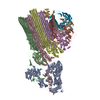 8b0gC 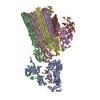 8b0hC M: map data used to model this data C: citing same article ( |
|---|---|
| Similar structure data | Similarity search - Function & homology  F&H Search F&H Search |
- Links
Links
- Assembly
Assembly
| Deposited unit | 
|
|---|---|
| 1 |
|
- Components
Components
-Protein , 2 types, 2 molecules AG
| #1: Protein |  Complement component 5 / C3 and PZP-like alpha-2-macroglobulin domain-containing protein 4 Complement component 5 / C3 and PZP-like alpha-2-macroglobulin domain-containing protein 4Mass: 188512.094 Da / Num. of mol.: 1 / Source method: isolated from a natural source / Source: (natural)   Homo sapiens (human) / References: UniProt: P01031 Homo sapiens (human) / References: UniProt: P01031 |
|---|---|
| #7: Protein | Mass: 13355.330 Da / Num. of mol.: 1 Source method: isolated from a genetically manipulated source Source: (gene. exp.)   Escherichia coli (E. coli) / Gene: CD59, MIC11, MIN1, MIN2, MIN3, MSK21 / Production host: Escherichia coli (E. coli) / Gene: CD59, MIC11, MIN1, MIN2, MIN3, MSK21 / Production host:   Escherichia coli (E. coli) / References: UniProt: P13987 Escherichia coli (E. coli) / References: UniProt: P13987 |
-Complement component ... , 5 types, 5 molecules BCDEF
| #2: Protein | Mass: 104918.180 Da / Num. of mol.: 1 / Source method: isolated from a natural source / Source: (natural)   Homo sapiens (human) / References: UniProt: P13671 Homo sapiens (human) / References: UniProt: P13671 |
|---|---|
| #3: Protein | Mass: 93625.328 Da / Num. of mol.: 1 / Source method: isolated from a natural source / Source: (natural)   Homo sapiens (human) / References: UniProt: P10643 Homo sapiens (human) / References: UniProt: P10643 |
| #4: Protein | Mass: 67136.891 Da / Num. of mol.: 1 / Source method: isolated from a natural source / Source: (natural)   Homo sapiens (human) / References: UniProt: P07358 Homo sapiens (human) / References: UniProt: P07358 |
| #5: Protein | Mass: 65239.152 Da / Num. of mol.: 1 / Source method: isolated from a natural source / Source: (natural)   Homo sapiens (human) / References: UniProt: P07357 Homo sapiens (human) / References: UniProt: P07357 |
| #6: Protein | Mass: 22302.424 Da / Num. of mol.: 1 / Source method: isolated from a natural source / Source: (natural)   Homo sapiens (human) / References: UniProt: P07360 Homo sapiens (human) / References: UniProt: P07360 |
-Sugars , 3 types, 4 molecules 
| #8: Polysaccharide |  / Mass: 424.401 Da / Num. of mol.: 2 / Mass: 424.401 Da / Num. of mol.: 2Source method: isolated from a genetically manipulated source #9: Polysaccharide | beta-D-mannopyranose-(1-4)-2-acetamido-2-deoxy-beta-D-glucopyranose |  / Mass: 383.349 Da / Num. of mol.: 1 / Mass: 383.349 Da / Num. of mol.: 1Source method: isolated from a genetically manipulated source #11: Sugar | ChemComp-NAG / |  N-Acetylglucosamine N-Acetylglucosamine |
|---|
-Non-polymers , 1 types, 2 molecules 
| #10: Chemical |
|---|
-Details
| Has ligand of interest | N |
|---|
-Experimental details
-Experiment
| Experiment | Method:  ELECTRON MICROSCOPY ELECTRON MICROSCOPY |
|---|---|
| EM experiment | Aggregation state: PARTICLE / 3D reconstruction method:  single particle reconstruction single particle reconstruction |
- Sample preparation
Sample preparation
| Component |
| ||||||||||||||||||||||||||||
|---|---|---|---|---|---|---|---|---|---|---|---|---|---|---|---|---|---|---|---|---|---|---|---|---|---|---|---|---|---|
| Molecular weight | Experimental value: NO | ||||||||||||||||||||||||||||
| Source (natural) |
| ||||||||||||||||||||||||||||
| Source (recombinant) | Organism:   Escherichia coli (E. coli) Escherichia coli (E. coli) | ||||||||||||||||||||||||||||
| Buffer solution | pH: 7.5 | ||||||||||||||||||||||||||||
| Specimen | Embedding applied: NO / Shadowing applied: NO / Staining applied : NO / Vitrification applied : NO / Vitrification applied : YES : YES | ||||||||||||||||||||||||||||
| Specimen support | Grid material: COPPER / Grid mesh size: 300 divisions/in. / Grid type: Quantifoil R1.2/1.3 | ||||||||||||||||||||||||||||
Vitrification | Instrument: FEI VITROBOT MARK IV / Cryogen name: ETHANE / Humidity: 95 % / Chamber temperature: 294 K |
- Electron microscopy imaging
Electron microscopy imaging
| Experimental equipment |  Model: Titan Krios / Image courtesy: FEI Company |
|---|---|
| Microscopy | Model: FEI TITAN KRIOS |
| Electron gun | Electron source : :  FIELD EMISSION GUN / Accelerating voltage: 300 kV / Illumination mode: FLOOD BEAM FIELD EMISSION GUN / Accelerating voltage: 300 kV / Illumination mode: FLOOD BEAM |
| Electron lens | Mode: BRIGHT FIELD Bright-field microscopy / Nominal defocus max: 2400 nm / Nominal defocus min: 900 nm / Cs Bright-field microscopy / Nominal defocus max: 2400 nm / Nominal defocus min: 900 nm / Cs : 2.7 mm / C2 aperture diameter: 100 µm : 2.7 mm / C2 aperture diameter: 100 µm |
| Specimen holder | Cryogen: NITROGEN / Specimen holder model: FEI TITAN KRIOS AUTOGRID HOLDER |
| Image recording | Average exposure time: 9.8 sec. / Electron dose: 50 e/Å2 / Film or detector model: FEI FALCON IV (4k x 4k) / Num. of grids imaged: 2 / Num. of real images: 12805 |
| Image scans | Width: 4096 / Height: 4096 |
- Processing
Processing
| Software |
| |||||||||||||||||||||||||||||||||||||||||||||||||||||||
|---|---|---|---|---|---|---|---|---|---|---|---|---|---|---|---|---|---|---|---|---|---|---|---|---|---|---|---|---|---|---|---|---|---|---|---|---|---|---|---|---|---|---|---|---|---|---|---|---|---|---|---|---|---|---|---|---|
| EM software |
| |||||||||||||||||||||||||||||||||||||||||||||||||||||||
CTF correction | Type: PHASE FLIPPING AND AMPLITUDE CORRECTION | |||||||||||||||||||||||||||||||||||||||||||||||||||||||
| Particle selection | Num. of particles selected: 1138825 Details: CrYOLO neural network based particle picking, standard model, low threshold (0.01). | |||||||||||||||||||||||||||||||||||||||||||||||||||||||
3D reconstruction | Resolution: 3 Å / Resolution method: FSC 0.143 CUT-OFF / Num. of particles: 206782 / Algorithm: BACK PROJECTION / Num. of class averages: 2 / Symmetry type: POINT | |||||||||||||||||||||||||||||||||||||||||||||||||||||||
| Atomic model building | B value: 87 / Protocol: FLEXIBLE FIT / Space: REAL Details: Initial rigid body fits were performed using UCSF Chimera and UCSF ChimeraX. Carbohydrates were added using Coot. Models were refined iteratively using Isolde and Phenix Real Space Refine. | |||||||||||||||||||||||||||||||||||||||||||||||||||||||
| Refinement | Cross valid method: NONE Stereochemistry target values: GeoStd + Monomer Library + CDL v1.2 | |||||||||||||||||||||||||||||||||||||||||||||||||||||||
| Displacement parameters | Biso mean: 86.95 Å2 | |||||||||||||||||||||||||||||||||||||||||||||||||||||||
| Refine LS restraints |
|
 Movie
Movie Controller
Controller








 PDBj
PDBj
